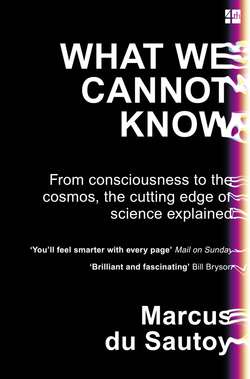Читать книгу What We Cannot Know: Explorations at the Edge of Knowledge - Marcus Sautoy du - Страница 42
ZOOMING IN
ОглавлениеTo predict how the dice might land I need to know what my cube is made from. Denser acetate in one corner of the shape will lead to one side of the dice being favoured over the others. So if I am going to attempt to apply Newton’s laws to my dice as it tumbles through the air, I need to know how my dice is put together. Is it a continuous structure, or, if I look closely, is it made up of discrete pieces?
If I accept the limits of my own vision, as Schopenhauer’s quote at the beginning of this Edge suggests I tend to, then I can’t see anything other than the clear red acetate that makes up the dice. But with an optical microscope I can magnify the dice by a factor of 1500, which would scale my dice up to the size of a large building. Peering inside this huge dice still won’t reveal much about the secrets of how it is built. Everything still looks pretty smooth and continuous.
In the twentieth century microscopes exploiting different bits of the electromagnetic spectrum have allowed scientists to create images which magnify things a further 1000 times. Now my dice will span from one side of London to the other. At this magnification the dice is looking grainier. The sense of the continuous structure is giving way to something more discrete. Current electron microscopes allow me to zoom in another 10 times closer, at which point I might start to see the carbon and oxygen atoms that I know are some of the ingredients of the acetate from which my dice is made.
The intriguing thing is that scientists had already formulated an atomic view of matter long before I could actually see these atoms under the modern microscopes in the labs across the road from the mathematics department. And it is a combination of a mathematical and theoretical perspective with a physical vision that is the best tool for knowing what my dice is made from.
But atoms like oxygen and carbon turned out not to be as atomic as the name suggests. Beyond the atomic structure revealed by current electron microscopes, I know that there is more internal structure. Atoms give way to electrons, protons and neutrons. Protons and neutrons in turn give way to quarks. In 2013 quantum microscopes even captured pictures of electrons orbiting the nucleus of a hydrogen atom. But is there a theoretical limit to how far I can dig down inside my dice?
What happens, for example, if I take my dice and keep dividing it in half? Just how far can I go? The mathematical side of me says: no problem. If I have a number I can keep dividing it by two:
There is no point mathematically where I have to stop. Yet if I start trying to do the same thing with the physical dice sitting on my desk and cut it in half, then in half again, just how far can I keep going?
The tension between the continuous versus the discrete nature of matter, between what is possible mathematically versus the limits placed by physical reality, has been raging for millennia. Is the universe dancing to the sound of my trumpet or shimmying to the glissando of my cello?
